What To Feed Baby Quail
When it comes to nurturing baby quail, the key lies in providing them with the right nutrition. After hatching, it’s crucial to choose the appropriate feed that caters to their specific needs. Opt for a quail-specific starter feed, or consider a gamebird, turkey, or pheasant starter feed. These options are rich in protein, promoting optimal body development—a crucial aspect during their early stages of life, mirroring their dietary preferences in their natural habitat.
To ensure your baby quail receives adequate light, incorporating artificial lighting into their cage is highly beneficial. This not only meets their light requirements but also encourages female quails to continue laying even during the winter months.
Can quail eat carrots?
What is a starter feed?
A starter feed is a crucial dietary component for the initial stages of a baby’s quail’s development. It consists of a nutritionally balanced mixture, typically containing around 24% or more protein. The primary purpose of the starter feed is to provide essential nutrients that support the healthy growth and maturation of quail. Unlike chicken starter feed, which contains less protein, the specific nutritional requirements of baby quail are met by incorporating ingredients such as bugs, insects, worms, mealworms, snails, or slugs.
In the early stages, quail, being game birds, demand a higher percentage of protein, akin to the diets of pheasants and turkeys. This distinctive dietary need makes the starter feed a critical element in ensuring the proper development of quail. If a dedicated quail starter feed is unavailable, a generic gamebird starter crumble with 24% protein can be an effective substitute. Additionally, if circumstances dictate the use of non-medicated chicken starter feed, it is possible to enhance its protein content by supplementing the diet with mealworms, snails, or slugs.
When to switch diet?
Understanding the growth and development of quails is essential to determine when to switch their diet. Quail chicks experience rapid growth, with a significant transformation in appearance within a short span of two weeks. By the age of eight weeks, they typically reach their maximum size and weight.
The key factor indicating the appropriate time to switch their diet is sexual maturity. Hens begin laying eggs regularly, and roosters become active in breeding and crowing around the age of six to eight weeks. At this stage, a transition from the starter feed to a layer feed is recommended.
The layer feed differs by being lower in protein and higher in calcium (around 1.5-2%). This specific composition supports the quails in producing eggs with strong shells. Therefore, to ensure optimal nutrition and egg production, it is advisable to switch to the layer feed when the quails reach sexual maturity, typically between six and eight weeks of age.
How to feed baby quail?
To ensure the optimal feeding of baby quail, it is crucial to consider their size and developmental stages. Day-old quail chicks are significantly smaller than newly hatched chickens, making it challenging for them to swallow standard grains of starter feed. In the initial five days, it is recommended to ground their food using a mixer or by crushing it to a more manageable consistency.
While none of the quails experienced choking due to large grains, a potential hazard emerged when one quail swallowed a small piece of eggshell after hatching. It’s important to note that the size of the grain matters, as evidenced by the unfortunate incident.
Around the fifth day of age, the quail chicks will have grown sufficiently, eliminating the need to continue grinding their food. This adjustment aligns with their developmental progress, ensuring a smoother transition in their feeding routine.
How much do baby quail eat?
In their first days, these tiny birds consume only a few grams a day, gradually increasing as they grow. After a week, the intake rises to 10-15 grams daily, reaching around 25 grams by the second week.
It’s essential to provide constant access to both food and water. Interestingly, quail won’t overeat; they instinctively consume what’s necessary for their development. Observing them can help – when not hungry, they rest beside their feed.
However, baby quail can be messy eaters. They exhibit a unique behavior, shaking their heads as their beaks touch food, often resulting in spilled grains. To mitigate waste, placing their food on the floor initially is recommended, using a paper or shallow tray. As they learn to eat, a simple solution is employing a Tupperware box with holes cut on the side to catch spilled grains.
By understanding their gradual increase in food intake, and messy eating habits, and providing practical solutions for minimizing waste, you ensure the healthy development of your baby quail.
Implementing crucial feeding practices for raising young quails.
To ensure successful full-fledged production and proper growth of baby quails, it is crucial to adhere to a well-planned day-to-day feeding routine. Here are essential steps to effectively manage their feeding:
Types of feed and nutrition:
When it comes to essential feeding management for raising baby quails, it is crucial to start with a well-balanced diet. Begin with a game birds starter mix containing grain crushes like corn, wheat, oats, barley, and sunflower seeds. This mix is enriched with higher protein levels, ranging from 20% to 35%, facilitating faster growth during the initial months.
Avoid pellet forms as they can be challenging for baby quails to swallow. Opt for feeds in the form of crumbles for easier consumption. As they progress in age, gradually transition to a game bird grower mix. Introduce various green leaves into their diet to diversify their nutritional intake.
Remember, baby quails require careful attention to their feed, with 25% consumption based on their body weight. Following this feeding regimen diligently ensures that they thrive and grow efficiently. With the right nutritional balance and timely adjustments, baby quails can reach maturity quickly, making the process of raising them a rewarding experience.
Provide sufficient clean water
Baby quails have distinct preferences, and clean water plays a pivotal role in their overall well-being. Unlike some other gaming birds or chickens, baby quails exhibit a preference for drinking clean water.
In the wintertime, it becomes even more important to provide warm, clean water for your baby quails. This not only addresses their basic requirement for hydration but also helps them cope with colder temperatures. As an expert in quail care, I recommend ensuring that the water is not only clean but also at an appropriate temperature during the winter season.
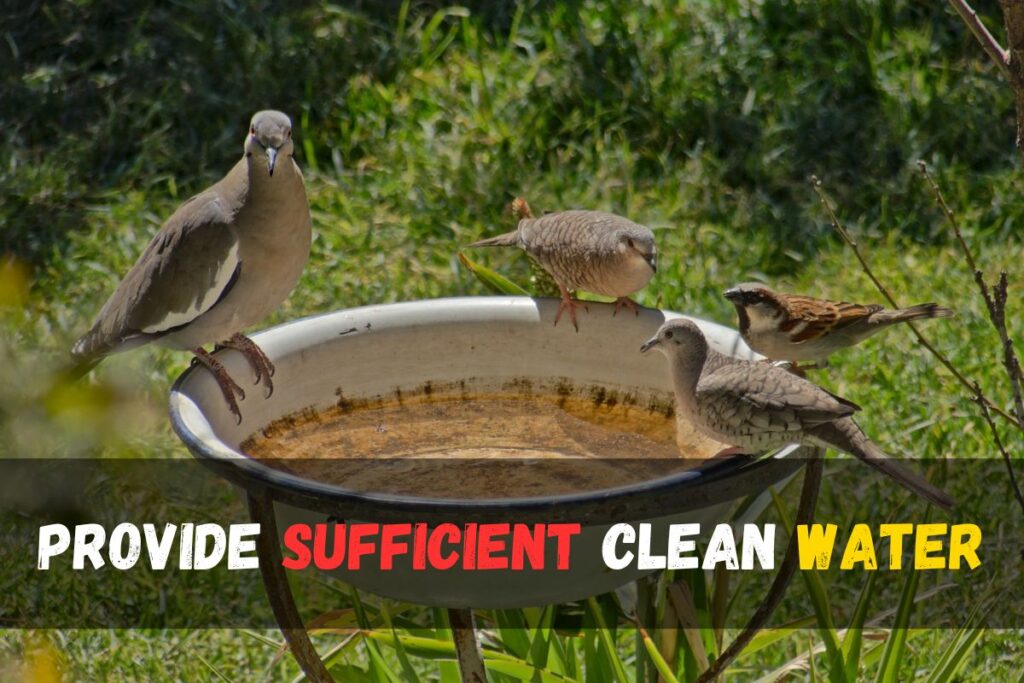
A useful tip to enhance feeding management is to incorporate apple cider vinegar into the water. This not only adds flavor but also serves as a natural remedy to combat parasites. By mixing one spoon of apple cider vinegar with the water, you create a solution that contributes to the overall health of your baby quails.
Proper feeding and watering equipment:
When raising baby quails, ensuring proper feeding and watering equipment is crucial for their well-being. Avoid using open pots for water, as baby quails may drown. Instead, opt for a water container with small openings to prevent accidents. Similarly, provide small feeding pots to discourage them from using them as a toilet or tub.
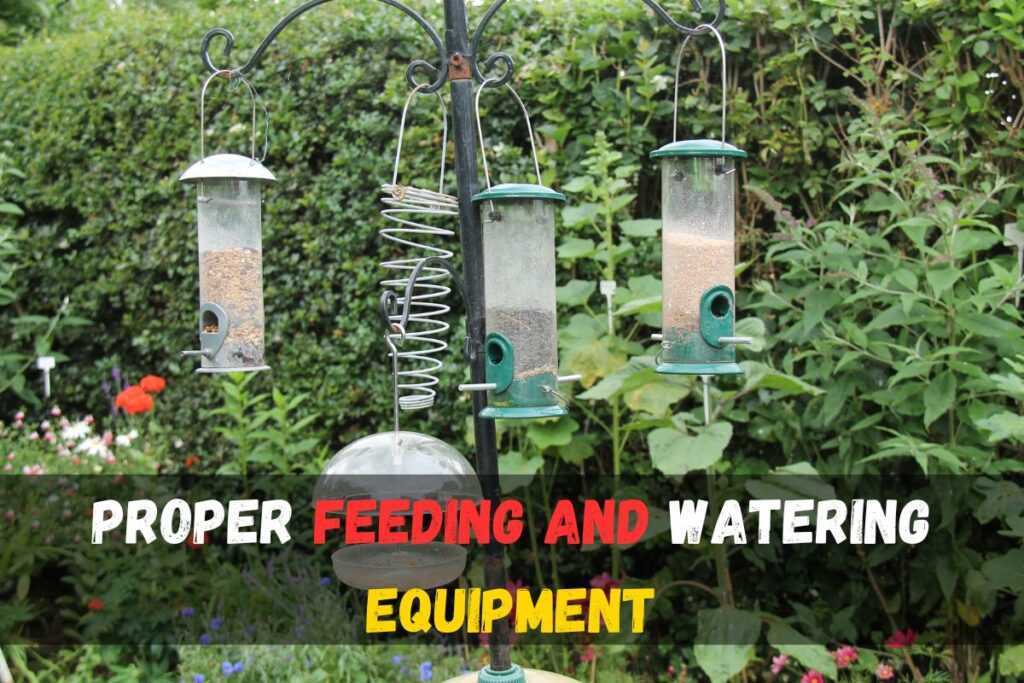
In terms of quail feeding material, make sure there is enough space for the quails to eat without fighting for food. Since baby quails tend to be untidy eaters, store the feed in a designated area with “anti-spill fingers” to maintain cleanliness.
Clean feeding equipment:
To create an ideal environment for their development, it is essential to maintain a clean and hygienic space.
Start by establishing a feeding area that is kept dry and protected from elements such as rainfall, wind, and direct sunlight. The avoidance of a wet and dumpy area is paramount, as it serves as the main breeding ground for mold and infections that pose a serious threat to baby quails.
Regular cleaning of the feeding equipment is a fundamental aspect of maintaining a healthy environment. Clean the feeding tools every one or two days and replace the water daily to prevent bacterial growth. Additionally, a thorough cleaning of the entire area using a non-toxic disinfectant should be performed at least twice a week.
By following these essential steps, you not only ensure the cleanliness of the feeding equipment but also create a hygienic space that minimizes the risk of infections, promoting the overall well-being and successful growth of your baby quails.
Storing the feed:
It is crucial to store their food correctly. Store the feed in a dry, hard container to prevent mold, which can be dangerous for the quails. Additionally, aim to finish the feed before it expires, typically two to three weeks after the manufacturing date in humid and hot conditions. Regularly check the storage place to maintain suitable conditions. The use of a secure container is also essential to avoid contamination by rats and insects, ensuring the feed’s quality. Following these guidelines guarantees a healthy and thriving environment for the baby quails, emphasizing proper storage and timely consumption for their optimal growth.
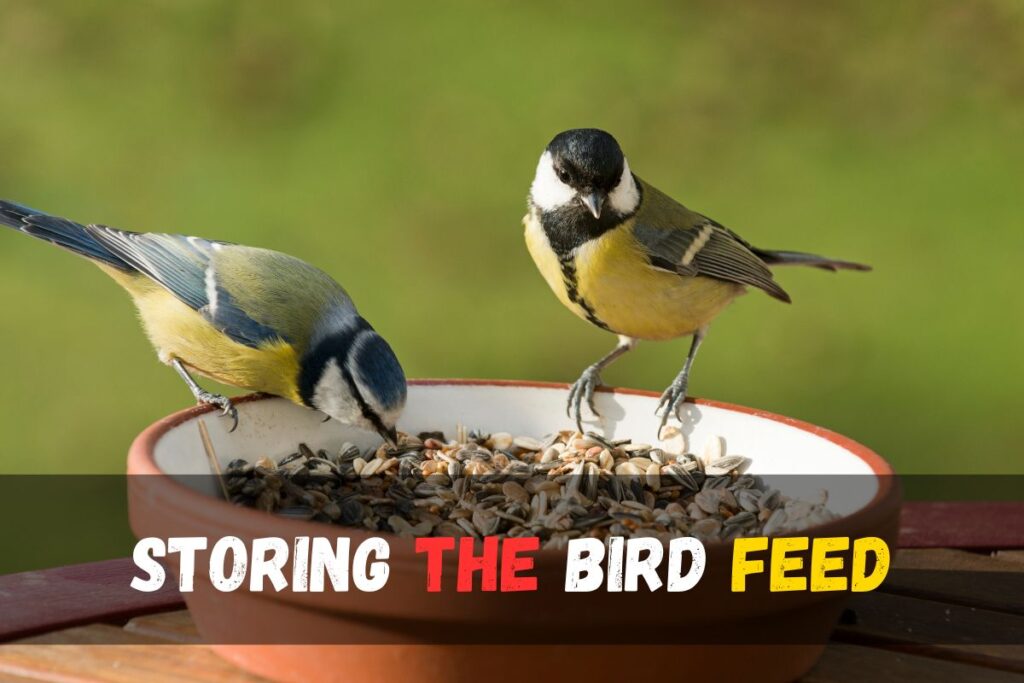
Introducing the supplemental food:
Baby quails, in their quest for food, thrive in a diet rich in diversity. To raise them successfully, one should introduce a variety of elements into their feeding routine.
Start by incorporating different herbs and leaves into their diet, mimicking the environment they would naturally forage in. Additionally, offer a mix of fruits and vegetables such as blackberries, snowberries, Oregon grapes, broccoli, carrots, and lettuce. These choices provide essential nutrients and contribute to a well-rounded diet for growing quails.
Moreover, quails have a penchant for nuts and seeds, so including these in their feeding regimen can be beneficial. Ensure that the nuts and seeds are appropriate for their size and age, promoting healthy growth and development.
Eating etiquette and taming:
Eating etiquette and taming are crucial aspects of effectively managing and raising baby quails. Understanding the messy eating habits of baby quails is essential for daily care. Teaching them the proper way to eat and drink ensures their well-being.
When you have some time, demonstrate to the baby quails how to dip their beaks into the bowl to drink water and feed. If the mommy quail is present, she will play a role in teaching them these important skills.
To foster a bond with the quails, invest time and patience. Begin the taming process by holding the feed in both hands and placing the baby quail over it. This interaction allows the quails to familiarize themselves with you, contributing to a successful taming experience. Always remember to clean your hands before touching or handling the baby quails.
Feeding environment:
Create a calm environment by minimizing loud noises, hushed tones, and sudden movements. These actions help prevent the chicks from feeling scared, as they may associate such sounds with the presence of predators. Place them in a quiet area to encourage a stress-free atmosphere.
It’s crucial to avoid placing baby quails in spaces with excessive noise, as they tend to hide and refrain from eating for extended periods, negatively impacting their growth. Opt for a tranquil setting to promote their comfort, allowing them to eat properly.
Additionally, be mindful of potential predators, such as dogs and cats. Keep them away from the same room where the quail chicks are housed to ensure their safety.
Toxic food that should avoid
Raising baby quails requires careful consideration of their dietary needs to ensure their well-being and proper growth. Avoiding certain toxic foods is crucial in maintaining a healthy environment for these sophisticated birds. Harmful foods include salty foods, grape seeds, chocolate, caffeine, raw potatoes, avocado, parsley, leeks, most citrus fruits, onions, bulb garlic, and more.
If you have a garden area where the quails roam, it’s essential to be aware that they can easily access plants that might be dangerous for them. To promote their growth, it’s advised not to feed them excessive starch or seeds, as this may lead them to ignore the higher protein pellets, which are vital for their development.
FAQ’S
How Long Can Baby Quail Go Without Food?
Baby quail, being more sensitive birds, cannot survive a day without food. It is crucial to provide them with a warm environment and offer crushed food since pellets are difficult for them to swallow. Ensuring a timely and appropriate food supply is essential for the well-being and survival of baby quail. In their delicate state, they require constant nourishment to thrive, emphasizing the importance of regular feeding intervals to sustain their health and development.
What Fruit And Vegetables Can Quail Eat?
Quail has a diverse palate when it comes to exploring tastes in nature. They particularly enjoy a variety of fruits and vegetables as part of their supplement feed. Some fruits that quail can relish include blackberry, Oregon grapes, salad, and snowberry. In the vegetable department, they favor broccoli, cucumber, cabbage, and carrots. These delightful choices make up a nutritious and well-rounded diet for quail, allowing them to enjoy a balanced and tasty meal.
Remember, it’s important to offer these options in moderation, ensuring that quail receives a mix of flavors and nutrients without overdoing it. This approach contributes to their overall health and well-being.
Can A Baby Quail Eat Chick Starter?
Yes, a baby quail can eat chick starters. However, it is advisable to provide them with a game bird starter instead of a regular chick starter. This is because the game bird starter contains 21% more protein, which is essential for the healthy growth and development of the baby quail. Choosing the right starter ensures that the nutritional needs of the quail are met adequately
Can I Feed Quail Chicken Feed?
It’s not advisable to feed quail chicken feed because quail requires a higher protein content, specifically 18-30%, compared to what is suitable for chickens. For optimal results in their absolute growth, it is recommended to provide quail with gaming bird’s mix feed. This specialized feed caters to the unique dietary needs of quail, ensuring their well-being and development without compromising on essential nutrients.
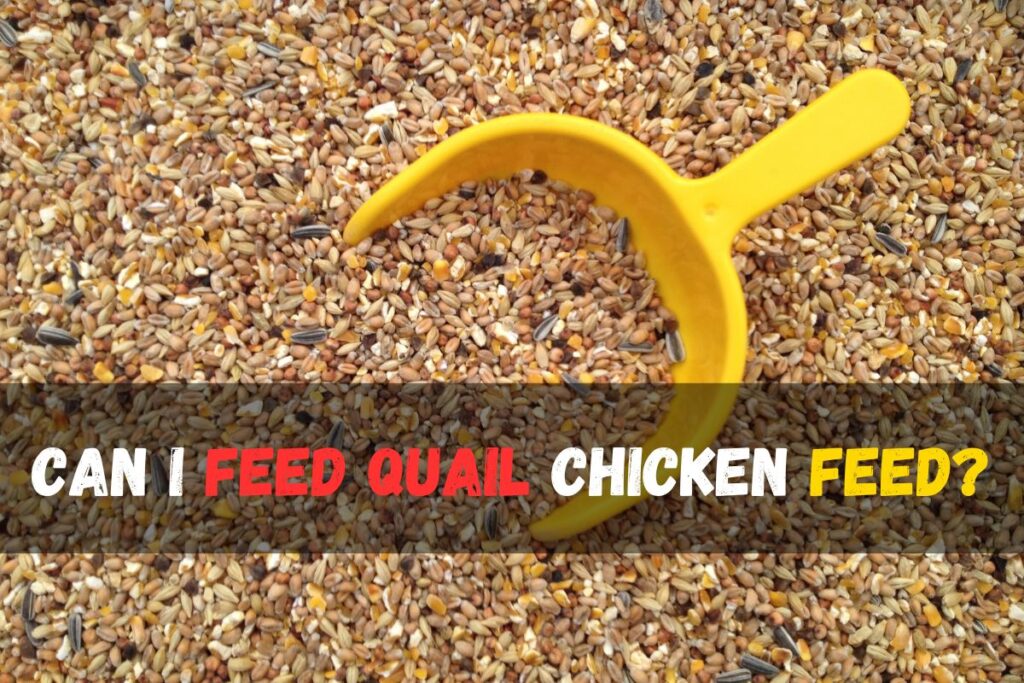
What do you feed a baby quail homemade?
Feeding a baby quail at home can be conveniently done with a few key considerations. The primary option is to provide Chick Crumbs, which are ideally suited for chicks, including ducklings. These crumbs are of the perfect size and consistency, ensuring easy consumption without the need for grit during digestion. Whether you choose to feed your quail chicks Turkey Chick Crumb from a local store or any other suitable option, it’s essential to keep fresh crumbs available at all times.
For feeding, you can use a small bowl or opt for larger feeders, especially if you are raising more than a handful of chicks simultaneously. However, be cautious as larger feeders might make the process a bit wobbly, leading to a potential mess.
In case you run out of chick crumbs or face any unexpected situations, a viable alternative is hard-boiled egg yolk. Remove the whites, break the yolk into tiny pieces, and offer it to the chicks. While egg yolk contains everything a freshly hatched chick needs, it lacks the nutritional requirements for a growing chick. Therefore, only resort to feeding yolk as a temporary solution while ensuring to arrange proper feed for long-term nutrition.
It’s crucial to note that feeding egg yolk should be a last resort, particularly for about the first two weeks. During this time, focus on acquiring the appropriate feed to support the healthy growth of your quail chicks.
What do you feed an abandoned baby quail?
To properly nourish an abandoned baby quail, you should offer a well-balanced diet that mimics its natural nutritional needs. Consider providing finely chopped hard-boiled eggs, alfalfa sprouts, or finely chopped broccoli florets as temporary foods. Additionally, you can source quail-appropriate nutrition from a feed store, such as turkey or game bird starter. Tiny mealworms can also be a suitable option.
When dealing with an abandoned baby quail, it’s crucial not to handle the chick excessively, and it’s advised to refrain from allowing children to play with it. This approach ensures minimal stress for the quail and promotes its overall well-being.
Remember, catering to the specific dietary requirements of a baby quail is essential for its growth and development. Providing a diverse and nutritious diet will contribute to the quail’s health and increase its chances of thriving in its environment.
How do you take care of a baby quail?
Taking care of baby quail requires attention to their specific needs during their initial stages of life. These small birds, especially as chicks, demand careful handling to ensure their well-being. Here are essential steps to nurture baby quail effectively:
- Isolation: Keep baby quail away from other animals, except their mother hen if applicable. This prevents potential harm and allows the quail to develop without unnecessary stress.
- Brooder Setup: Provide a suitable brooder, ensuring a safe and warm environment for the chicks. Use soft bedding to create a comfortable space where they can rest and move around easily.
- Nutrition: Supply a well-balanced diet containing appropriate quail feed. Ensure that the food is finely crushed to accommodate the small size of the chicks. This diet should be rich in the necessary nutrients for their growth.
- Hydration: Always provide access to clean and fresh water. Quail chicks, like any young birds, need proper hydration for their development. Check regularly to ensure the water source remains clean.
- Temperature Control: Maintain a consistent and suitable temperature in the brooder. Adjust the heat source to mimic the conditions they would experience with their mother. This helps regulate their body temperature and fosters healthy growth.
- Observation and Interaction: Spend time observing the baby’s quail to monitor their behavior and health. While they may not require constant handling, periodic checks help identify any issues early on.
- Gradual Introduction to Solid Food: As they grow, introduce solid food gradually to transition them from an all-liquid diet. This process ensures they develop the ability to eat different types of food.
By following these steps, you’ll create an environment that promotes the healthy development of baby quail, allowing them to thrive during their initial weeks of life.
Do baby quails eat rice?
Yes, baby quails can eat rice as part of their diet. While the main portion of their diet should consist of specialized quail feed, rice can be included as a treat. It’s essential to provide a balanced and varied diet for baby quails, incorporating different food items like rice along with other treats such as cake, pasta, sweet corn, nuts, and seeds. This ensures that they receive the essential nutrients required for robust growth. Remember to monitor their intake and maintain a well-balanced diet to keep them happy and healthy.
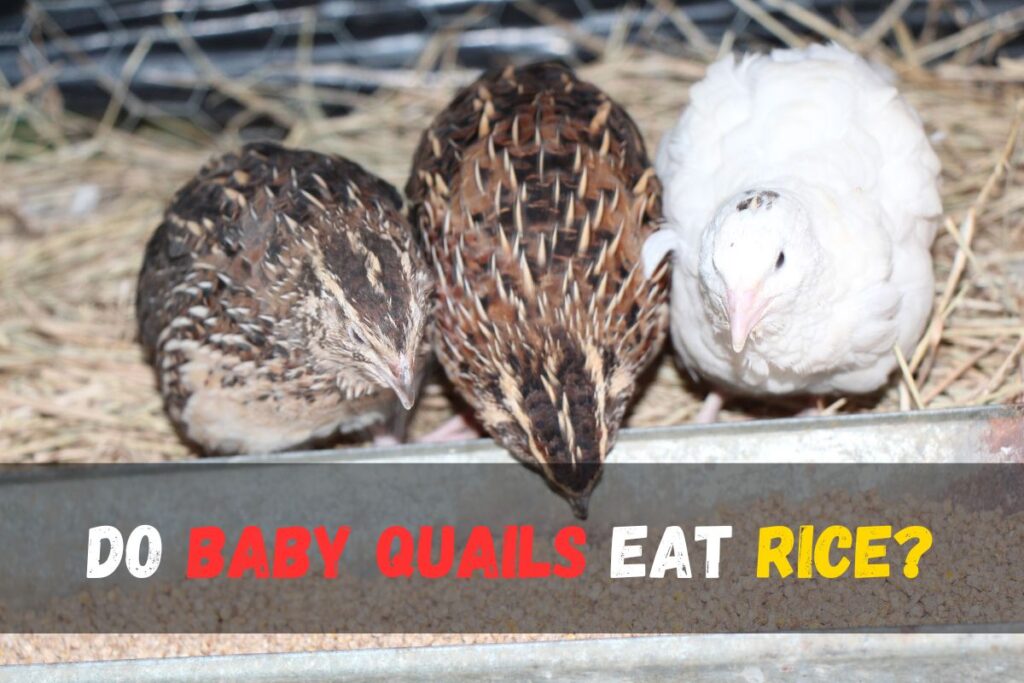
Can baby quail live alone?
Gambel’s quail, being small and vulnerable, faces numerous natural predators such as roadrunners and woodpeckers. According to Jeani Garrett from Arizona Covey Quail Rescue, the absence of a mother’s warmth can be detrimental to the survival of a baby quail. Hatchlings without their parents may struggle to survive alone. The crucial bond with their parents, particularly the nurturing warmth provided by the mother, plays a vital role in ensuring the well-being of baby quail. In essence, it is challenging for baby quail to live alone, as they heavily rely on the care and protection of their parents for their survival.
Do baby quails need heat?
Quail chicks require supplemental heat in a brooder until they reach full feathering, which typically occurs around 5 to 6 weeks of age. At the time of hatching, it is crucial to maintain the brooder temperature at chick level within the range of 96-98 degrees Fahrenheit. Gradually decrease the brooder temperature by 5 degrees for each subsequent week until the quail chicks are fully feathered. This ensures their comfort and well-being during the early stages of development.
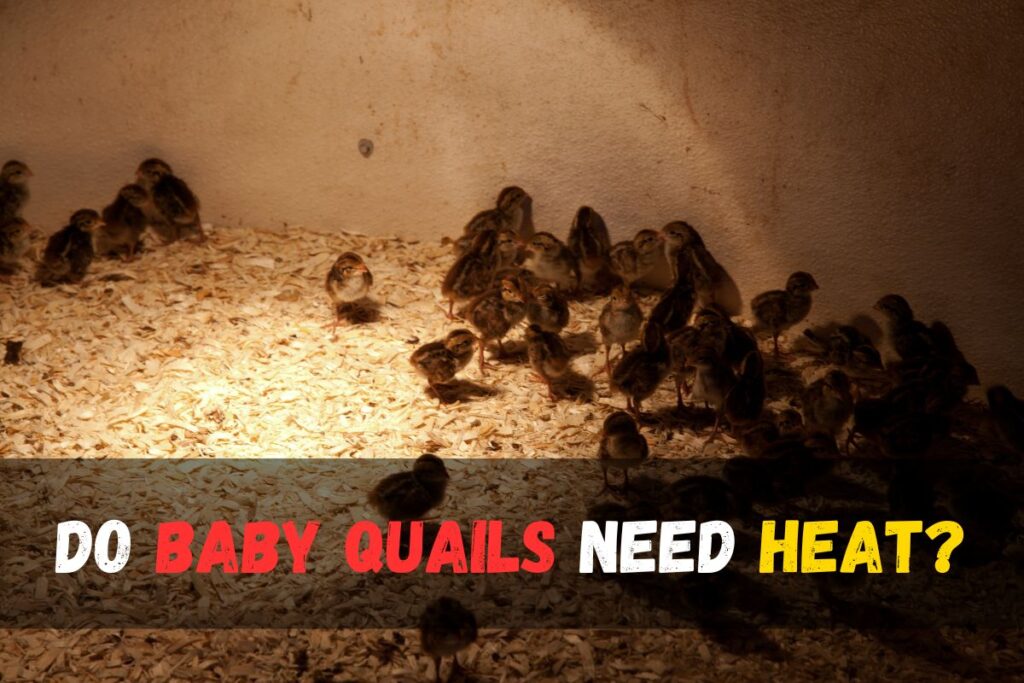
As a result, yes, baby quails do need heat to thrive and grow properly, especially during the initial weeks of their lives. Adjusting the brooder temperature based on their age is essential to support their development until they are fully feathered.
Do baby quails need sunlight?
Baby quails benefit greatly from sunlight for their overall well-being. In a quail pen during summer, even a small amount of sunlight is crucial. Despite temperatures reaching up to 40 degrees, it’s observed that quails still seek direct sunlight.
Sunlight is essential for various aspects of their health, including egg, claw, and beak development. Ideally, baby quails should receive a bit of sunlight every day. However, if not daily, exposure every second day or having occasional access to sunlight is still beneficial.

Observations indicate that commercial organizations housing quails in cages within large sheds without sunlight might be detrimental to their well-being. This lack of natural light is not conducive to their health, as evidenced by their behavior of fanning their wings out when allowed to sunbathe.
How do you give a baby quail water?
To ensure your baby quail stays hydrated, we suggest dipping their beaks in water when you transfer them to their new brooder. This helps teach them how to drink. Additionally, you can guide these little creatures towards the water bowl if they don’t discover it on their own. This method ensures a smooth transition and ensures the quail chicks know where to find water without any stress.
Do Baby Quails Need Vitamin Drops?
Bobwhite quail, like any other living beings, require proper nutrition for various aspects of their well-being. The essential components of a nutritionally adequate diet for baby quails include water, protein, carbohydrates, fats, minerals, and vitamins. These elements are crucial for their growth, bone formation, feather development, and overall health.
When it comes to vitamins, it’s important to note that a well-balanced diet should ideally provide the necessary vitamins for baby quails. However, whether they need vitamin drops specifically depends on the specific circumstances and the diet they are receiving. If the diet lacks certain essential vitamins, supplementation may be considered, but it’s crucial to consult with a veterinarian to ensure the right balance.


